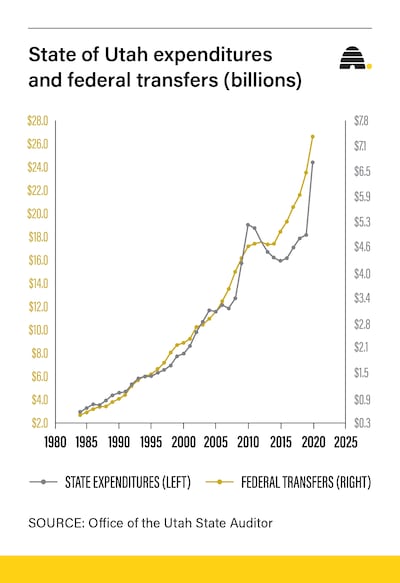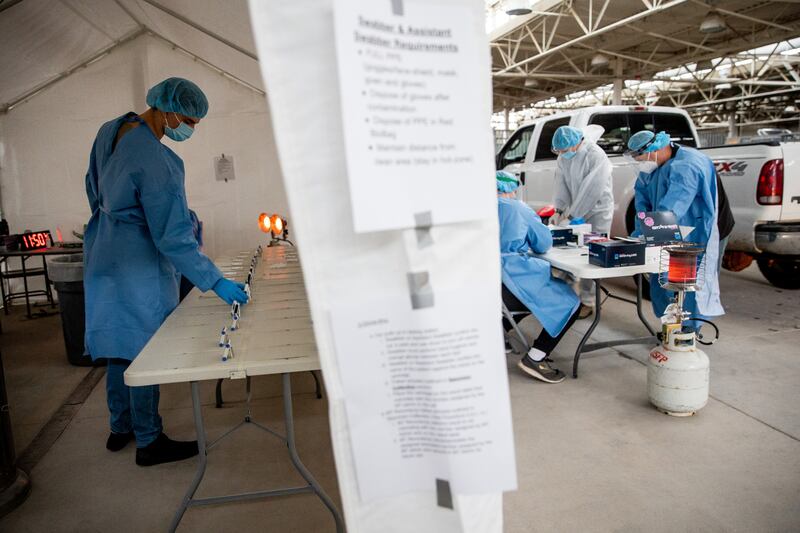In the year of the COVID-19 pandemic, the state of Utah spent more than $6.7 billion in federal funds — a number that has State Auditor John Dougall concerned about future reliance on federal subsidies.
Dougall, a Republican, also blasted Congress’ spending in a statement issued along with a report detailing the findings of his office’s 2020 Federal Funds Compliance Audit.
“The magnitude of the ongoing federal subsidy is troubling, due to Congress’ complete disregard for any sense of fiscal responsibility, the increasing dependence of state and local governments on federal subsidies, and the heightened economic and inflationary reactions from the magnitude of irresponsible federal spending,” Dougall said in Tuesday’s statement.
He also noted that some of the coronavirus relief money may have gone to “nonessential” needs because of a lack of proper oversight on local spending.
Dougall said auditors predict the state of Utah “will continue to experience increased dependency on federal money over the next five to 10 years as federal stimulus money continues to be sent to the state for multiple programs.”
“I urge caution as state leaders navigate the challenges that come with increased demands for ongoing spending built on one-time money,” he said.
The $6.74 billion in federal funds spent in 2020 represented more than 25% of Utah’s total fiscal year 2020 expenditures of $26.63 billion, according to the auditor’s office.
Last year’s spending reflects a sharp spike in federal transfers of funds and the state’s expenditures, exceeding a spike in spending between 2005 and 2010 amid weak economic conditions and in the wake of the Great Recession.
Dougall’s office audited state agencies’ compliance with federal regulations governing the use of the money. The report listed a slew of recommendations to increase compliance to address various issues found.
Dougall said the annual federal funds compliance audit is typically completed by December of each year, but “excessive delays by the federal government impacted this year’s reporting.” Federal guidance for auditing Coronavirus Aid, Relief, and Economic Security Act money wasn’t issued until late December, Dougall said, “more than nine months after that program started and after the office typically completes this audit work.”
Dougall thanked state agencies that, “despite managing the ongoing influx of federal pandemic money, supported the completion of this audit as quickly as possible after the guidance was issued.”
Lack of expertise in handling the funds cited
Amid a long list of recommendations included in the audit, Dougall’s office pinpointed some weaknesses that impacted the ability of the Governor’s Office of Management and Budget to manage disbursement of the funds.

“The Governor’s Office of Management and Budget (GOMB) did not have adequate federal grant management experience when the state received $943 million in Coronavirus Relief Fund (CRF) monies to aid in the state’s response to the pandemic” auditors wrote in the report. “As a result ... its internal controls over compliance with CRF requirements were insufficient.”
Auditors noted the budget office, “which does not typically manage federal programs, was charged with quickly disbursing the grant monies to state agencies and local governments, such as counties and cities.” The guidance provided to state agencies on how to spend the funds was “inconsistent with guidance provided to participating local governments,” and state agencies’ use of required coding when recording expenditures “was not consistently enforced.”
Auditors recommended the Governor’s Office of Management and Budget strengthen its grant management oversight by delegating the management of large federal programs to a state agency where managers have adequate experience with managing federal programs, hiring personnel with federal grant management experience, or designing an “effective internal control.”
Auditors also found “weaknesses” in the budget office’s monitoring of local governments’ use of COVID-19 relief funds. The office “did not completely fulfill its responsibilities in monitoring” local government spending as of June 2020, auditors wrote. Those included “communicating key federal grant information to participating local governments, evaluating each local government’s risk of not complying with grant requirements, and monitoring each local government’s compliance” with spending guidelines.
Of 17 local governments auditors evaluated (which aren’t named in the report), eight did not have “adequate supporting documentation to support the ‘necessary expenditure’ ... conclusion with respect to its employees, and all public safety and public health payroll costs were charged to the program,” auditors wrote. As a result, auditors said they are “questioning” more than $14.4 million in payroll expenditures across those local governments.
“While (the Governor’s Office of Management and Budget) considered itself a ‘banker,’ it did not consider itself a prime recipient responsible for ensuring local government compliance with (Coronavirus Relief Fund) regulations,” auditors wrote. “(The office) should communicate the necessary information to each participating local governments, establish written procedures for monitoring those local governments based on a formal risk assessment process, and should monitor the local governments for compliance with key terms and conditions in the agreement.
“The lack of monitoring or oversight,” auditors added, “has resulted in and may continue to result in material amounts of (coronavirus relief) funding paying for nonessential expenditures.”


